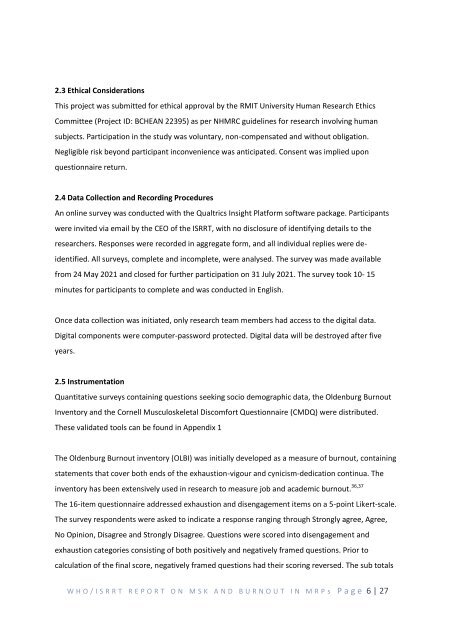Health_and_safety_of_Radiographers_and_WHO_MSK_Burnout_paper
You also want an ePaper? Increase the reach of your titles
YUMPU automatically turns print PDFs into web optimized ePapers that Google loves.
2.3 Ethical Considerations<br />
This project was submitted for ethical approval by the RMIT University Human Research Ethics<br />
Committee (Project ID: BCHEAN 22395) as per NHMRC guidelines for research involving human<br />
subjects. Participation in the study was voluntary, non-compensated <strong>and</strong> without obligation.<br />
Negligible risk beyond participant inconvenience was anticipated. Consent was implied upon<br />
questionnaire return.<br />
2.4 Data Collection <strong>and</strong> Recording Procedures<br />
An online survey was conducted with the Qualtrics Insight Platform s<strong>of</strong>tware package. Participants<br />
were invited via email by the CEO <strong>of</strong> the ISRRT, with no disclosure <strong>of</strong> identifying details to the<br />
researchers. Responses were recorded in aggregate form, <strong>and</strong> all individual replies were deidentified.<br />
All surveys, complete <strong>and</strong> incomplete, were analysed. The survey was made available<br />
from 24 May 2021 <strong>and</strong> closed for further participation on 31 July 2021. The survey took 10- 15<br />
minutes for participants to complete <strong>and</strong> was conducted in English.<br />
Once data collection was initiated, only research team members had access to the digital data.<br />
Digital components were computer-password protected. Digital data will be destroyed after five<br />
years.<br />
2.5 Instrumentation<br />
Quantitative surveys containing questions seeking socio demographic data, the Oldenburg <strong>Burnout</strong><br />
Inventory <strong>and</strong> the Cornell Musculoskeletal Discomfort Questionnaire (CMDQ) were distributed.<br />
These validated tools can be found in Appendix 1<br />
The Oldenburg <strong>Burnout</strong> inventory (OLBI) was initially developed as a measure <strong>of</strong> burnout, containing<br />
statements that cover both ends <strong>of</strong> the exhaustion-vigour <strong>and</strong> cynicism-dedication continua. The<br />
inventory has been extensively used in research to measure job <strong>and</strong> academic burnout. 36,37<br />
The 16-item questionnaire addressed exhaustion <strong>and</strong> disengagement items on a 5-point Likert-scale.<br />
The survey respondents were asked to indicate a response ranging through Strongly agree, Agree,<br />
No Opinion, Disagree <strong>and</strong> Strongly Disagree. Questions were scored into disengagement <strong>and</strong><br />
exhaustion categories consisting <strong>of</strong> both positively <strong>and</strong> negatively framed questions. Prior to<br />
calculation <strong>of</strong> the final score, negatively framed questions had their scoring reversed. The sub totals<br />
W H O / I S R R T R E P O R T O N M S K A N D B U R N O U T I N M R P s P a g e 6 | 27

















